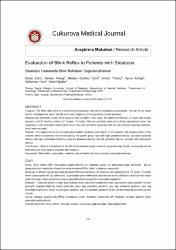Evaluation of blink reflex in patients with steatosis

Göster/
Erişim
info:eu-repo/semantics/openAccessTarih
2015Yazar
Cüre, ErkanKırbaş, Serkan
Cüre, Medine Cumhur
Tüfekçi, Ahmet
Kırbaş, Aynur
Yuce, Suleyman
Oğullar, Sabri
Üst veri
Tüm öğe kaydını gösterKünye
Cure, E., Kirbas, S., Cure, M.C., Tufekci, A., Kirbas, A., Yuce, S., Ogullar, S. (2015). Evaluation of blink reflex in patients with steatosis. Cukurova Medical Journal, 40(4), 714-722.Özet
Purpose: the blink reflex (BR) is a useful electrodiagnostic method for evaluating neuropathies. the aim of our study was to investigate the role of the BR in the early diagnosis of neuropathy in simple steatosis. Material and Methods: A total of 86 subjects were enrolled in this study: 56 patients (29 female, 27 male) with simple steatosis and 30 healthy controls (17 female, 13 male). After the electrical stimulation of the supraorbital nerve, two responses in the orbicularis oculi muscle occur, the early ipsilateral response and the late bilateral response latencies, which were recorded. Results: the triglyceride levels and lipid accumulation products were higher in the patients with steatosis than in the controls. When compared to the control group, the patient group had early right ipsilateral latency, late right ipsilateral latency, late right contralateral latency, early left ipsilateral latency, late left ipsilateral latency, and late left contralateral latency. Conclusion: There is a slowdown of the BR in the steatosis stage; therefore, by performing the BR, neuropathy can be detected at an early stage in patients with steatosis.

















